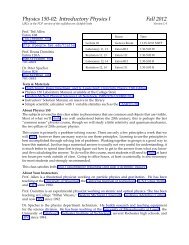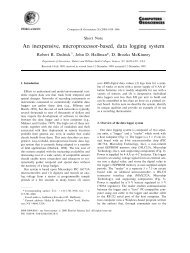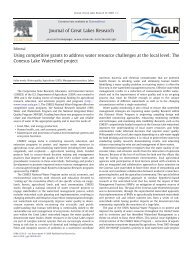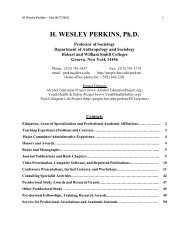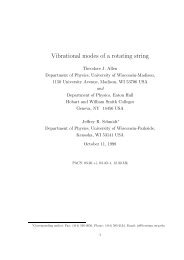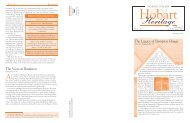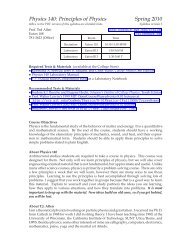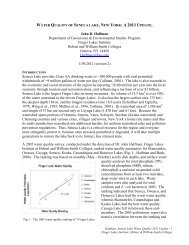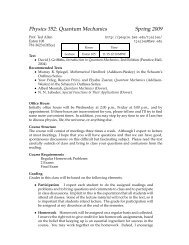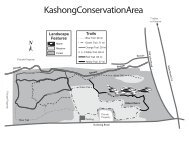Geology of New Zealand Field Trip Guidebook - ResearchGate
Geology of New Zealand Field Trip Guidebook - ResearchGate
Geology of New Zealand Field Trip Guidebook - ResearchGate
You also want an ePaper? Increase the reach of your titles
YUMPU automatically turns print PDFs into web optimized ePapers that Google loves.
Day 12—Tuesday 25 November. We will leave Tongariro behind and travel north into the<br />
Taupo Volcanic Zone and on toward Rotorua.<br />
Lake Taupo lies in the collapsed calderas <strong>of</strong> several enormous volcanoes that blew<br />
themselves up in a series <strong>of</strong> massive eruptions, the last <strong>of</strong> which occurred in 186 CE [Wilson,<br />
1980 #14]. Material from the Taupo eruptions are rhyolitic and spread over a large part <strong>of</strong><br />
the North Island. They include, pumice, ash and a non-welded ignimbrite (pyroclastic<br />
deposits). Estimates suggest that the eruption launched more than 60 km 3 <strong>of</strong> material more<br />
than 50 km into the sky. Some geologists estimate that the Taupo eruption <strong>of</strong> 186 CE was the<br />
most violent eruption <strong>of</strong> its kind ever studied (Wilson et al. 1980). Ash from the eruption<br />
spread worldwide producing strange skies as far away as China and Europe. An article by<br />
Wilson and colleagues (1980) describing a novel way <strong>of</strong> dating this eruption appears at the<br />
end <strong>of</strong> the guidebook.<br />
Stop 1: Five Mile Bay Recreation Area<br />
From this stop we can look across Lake Taupo to Western Bay, site <strong>of</strong> some <strong>of</strong> the most<br />
recent volcanic activity in the area. Looks peaceful doesn’t it? We want to look at three<br />
things here. First, the sand along the beach. Grab a handful and look carefully, definitely use<br />
a hand lens if you have one. The second thing to look at here are the deposits that make up<br />
the lake shore terraces to the east <strong>of</strong> the current shore line. Finally, notice the large boulders<br />
scattered along the shore. Notice that they are all about the same distance from the shore.<br />
Notebook Assignment: Describe the sand on the beach in detail, paying particular attention<br />
to its composition. Compare this sand with other sand you’ve described in your notebook<br />
from other places we have visited. Next, describe the terrace deposits. Finally, have a close<br />
look at the large boulders. After you have made some good observations, suggest how the<br />
two sets <strong>of</strong> observations are related.<br />
Some have suggested that the shoreline boulders actually floated into place. Although they<br />
seem too dense now, when hot and full <strong>of</strong> gas, some argue, they might have floated to the<br />
strand line, cooled and been deposited.<br />
Stop 2: Taupo<br />
We’ll stop briefly to have a look at this touristy town. The guidebooks say that Taupo “rivals<br />
Rotorua as the North Island’s capital <strong>of</strong> adrenalinised action.” It is a big tourist spot, both for<br />
Kiwis and foreign visitors. It is also <strong>New</strong> <strong>Zealand</strong>’s lake trout capital.<br />
Stop 3: Wairaikei Geothermal Power Plant viewing area<br />
Wairaikei was the first geothermal power station developed in <strong>New</strong> <strong>Zealand</strong>. Exploratory<br />
drilling began in 1950 and power generation started in 1958. The station produces about 150<br />
MW <strong>of</strong> electricity. Power is derived from hot water extracted from wells that penetrate an<br />
impermeable cap <strong>of</strong> sedimentary rocks into hot, fractured volcanic rocks below. The wells<br />
produce water at about 260°C, sufficiently hot to flash to steam at surface pressures. The<br />
steam drives turbines that produce electricity.<br />
In a world worried about burning fossil fuels for energy, geothermal seems like a<br />
good alternative for those places, like <strong>New</strong> <strong>Zealand</strong>, lucky enough to have high heat flow<br />
near the surface. However, geothermal energy is not entirely benign. Removing large<br />
amounts <strong>of</strong> water from the underground aquifer can cause the landscape to subside. This is a<br />
significant problem if your home—or town—happens to be built over the geothermal field.<br />
The water itself can also be problematic. Hydrothermal water may be acidic, contain lots <strong>of</strong><br />
45




